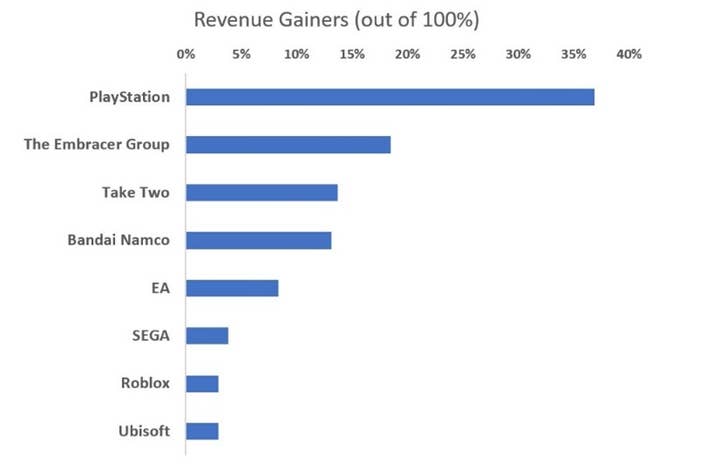2022 was notably a year of growth in the industry, not decline
SJN Insights' Sam Naji and Damian Abrahams explore what the biggest publishers' financials say about the market's performance last year
Economic confidence in 2022 took a battering. The global economy in 2022 was marked by war in Ukraine and a costly recovery from the pandemic. The subsequent supply chain and energy disruptions triggered a bout of inflation which central banks have struggled to contend with ever since.
Interest rates increased putting pressure on both the financial and real economy. Consumers had to make hard choices of where to cut expenditure and by how much. The year was marked with constant rumours of a recession. For many, those rumours were a technicality as the hallmarks of a recession had already set in.
When you work in the video game industry during an economic downturn, one question often arises: is the video game industry "recession proof"? Taking stock of this, one way to explore this is from the supply side. Let's examine how the video game industry performed in 2022 against this backdrop of tough economic headwinds. Two metrics will be explored: top line revenue (sales income) and operating income (profit). This may give us some clues how the industry will perform in 2023 with a few more tailwinds behind it.

From a layperson's point of view the general opinion is that 2022 has not been a great year for video games. During the first months of the year, it started strong with releases such as Elden Ring, Lego Star Wars: The Skywalker Saga, Horizon Forbidden West and Pokémon Legends: Arceus. These titles sold better than the first months of 2021 with releases such as Super Mario 3D World + Bowser's Fury and Monster Hunter Rise.
It looked so promising until May, when new AAA game releases all but dried up until the autumn. The dry spell of releases, combined with the decline in spending on catalogue games (the correction from the pandemic spike in sales) led many to speculate that 2022 was a bad year. It was a year for many in the industry, and for gamers, they would rather forget about.
The fascinating thing is when analysing the 2022 financial statements from the large video game publishers, this feeling of apathy was not borne out by their numbers.
To add consistency to the investigation:
- All fiscal statements have been adjusted to the seasonal calendar (January – December)
- Average 2022 foreign exchange rates has been used for the Yen (¥132 to $1), the Euro (€1.054 to $1) and the Chinese CNY (元6.72 to $1).
- Tencent numbers only include their video game revenues.
- Nintendo and Sony include revenue from hardware sales.
- Most of the publishers will also include revenues from mobile and other sources of income which may not be directly video game sales.
- It was not possible to get accurate data on Microsoft Xbox finances.
Revenue
The chart below shows a two-year trend for total revenue for thirteen of the largest publishers, excluding Microsoft.

The chart on the left shows total calendar 2022 revenue disclosed by company. The chart on the right illustrates their respective percentage year-on-year change compared to calendar 2021.
Eight of the thirteen publishers posted an increase in revenues for 2022 compared to 2021. When taking all thirteen publishers in total, revenue increased by 9%. That is an extra $8 billion spent by consumers.
Revenue for the top 13 publishers increased by 9%. That is an extra $8 billion spent by consumers
The situation for some publishers had been favourable due to the release of strong sales for their new releases, while for others it was primarily due to the consolidation of their live service games and DLC strategies. For example, the Embracer Group more than doubled its revenue, helped with the acquisitions of development houses Saber Interactive, DECA Games, Gearbox and Easybrain in the last two years.
Take- Two saw its revenue increase by 42% as it continued to see an expansion of its "Recurrent Consumer Spending". According to Take-Two fiscal Q3 2023 financials (calendar Q4 2022), 79% of total revenue came from recurring income (namely microtransactions), an increase from the 61% contribution posted a year ago.
Some of these large percentage increases in revenue disclosed by the companies can be somewhat deceptive. Given some companies are smaller in revenue base than others, any increase in revenue would seem large by comparison. A clearer idea of which company contributed the most, by way of revenue increase, would be to compare those revenue increases amongst each other; this is found in the chart below.

More than one third of the contributing revenue increase came from Sony's PlayStation division. This was almost twice the contribution in revenue increase that came from the Embracer Group (PlayStation increased revenue by $3.8 billion to the Embracer Group's $1.9 billion).
By comparison, revenue growth, in dollar terms, from the Embracer Group was more than double that to EA, and EA was more than double that of Sega, Roblox or Ubisoft.

The takeaway from this snapshot analysis is that 2022 was not a bad year at all when looking at it through the perspective of these companies P&Ls. If one were to add all the increases in revenue, combined it would come to an extra $11 billion in spending compared to 2021.
The recurring narrative from their financial disclosures is that where declines did occur it was mainly from catalogue spending. New game releases continued to show healthy numbers (such as God of War Ragnarök having the biggest launch in its franchise history, amongst others). The Gamesindustry.biz article 'Video game sales evade strong economic headwinds, for the time being' explores this phenomenon with greater detail.
When these healthy new games sales are combined with the growth in live services microtransaction spending, signs are that the industry has found a sustainable way for growth, even during strong economic uncertainties. If 2022 saw more tentpole titles get released, instead of being delayed to this year (and 2024), the gross position would most likely be even healthier.
This picture of resilient growth is probably best seen from a three-year perspective. The chart below shows the total revenue for the 13 tracked publishers since 2020.

The pace of revenue growth for some publishers has been exceptional. With the release of the PS5, Sony's PlayStation division boosted gross sales from $18.4 billion in 2020 to $24.6 billion. The PlayStation division now accounts for 30% of Sony's total revenue base, an increase of three percentage points in the past two years (data based on Sony's fiscal statement nine months ending December 2022). The PlayStation division is the biggest earner for the Sony business.
Over the last three years there was consistent growth from Bandai Namco, EA, Take-Two, Embracer Group, Sega and Roblox Inc. The increase in revenues for EA, Take-Two and Roblox were directly correlated to increased consumer spending on games and game-related content. This cannot be said for the others.
Nintendo may have plateaued in revenue growth, but it was still far the most profitable publisher
While release of the Elden Ring, Sonic Frontiers and Saints Row helped Bandai Namco, Sega and the Embracer Group respectively, video game sales only form part of their revenue base and some of the growth came from elsewhere. The good news is that even if revenue growth for publishers are not directly related to game sales, the bedrock for investment and the pool of money to engage in game development is there.
Obviously not every publisher did well. Nintendo lost money by a marginal amount every year during the last three years, even with record breaking games which released in 2022 such as Pokémon Scarlet and Violet and Splatoon 3. The strong release for Modern Warfare 2 did not reverse the fortunes for Activision Blizzard which saw a $1.3 billion drop in spending between 2021 and 2022 (almost two-thirds of the losses posted among the five publishers which posted a decline in dollar sales came from Activision Blizzard).
When adding the year-on-year losses for the five publishers that experienced a decline, consumers spent $2.1 billion less than in 2022 than they did in 2021. Although that decline was significant, it was still a quarter compared to the increase in spending from the eight publishers that posted growth. Growth in top line revenue in 2022 more than offset declines.
Operating Income
A downturn in revenue does not necessarily spell a problem if the underlying fiscal situation for a company is strong and this is borne out when looking at the operating incomes. For example, Nintendo may have plateaued in revenue growth, but it was still far the most profitable publisher, as laid out in the chart below.

Nintendo's net position in 2022 reached $4.9 billion, more than twice that of Sony's PlayStation division. Even those companies that posted declines in the top income such as Activision Blizzard and Square Enix declared a healthy profit of $1.5 billion and $584 million respectively. The largest turn-around in fortune was the Embracer Group which saw its net position of $3 million in 2021 increase to $380 million in 2022, an increase so large in percentage terms it was off the charts.
The only company whose net position posted a loss was Roblox Inc. Roblox has a set of circumstances which are unique to its business, and which I will cover off in a future article. It should be noted that Roblox net position is getting worse by the year and although the company declared greater revenues with every year, it is also posting greater losses as well.
Unfortunately, the picture was not completely rosy. Of the eleven companies whose net position could be ascertained, profits were down by $872 million, or 7%, between 2021 and 2022. There were many contributing factors to this, each unique to the companies concerned, but overall, the rising costs in game development is the common denominator.
In Summary
When summarising the calendar year 2022 top line and bottom-line revenue numbers for the top publishers in the video game industry the reading is one of confidence.
Apart from the additional year-on-year 9% in spending, the net position for almost all the companies was above zero, showing profit. For the PlayStation division at Sony, Bandai Namco, EA, Embracer Group and Sega, they all declared an increase in sales and operating income.
So you can see 2022 was not all bad for the video game industry.
Sam Naji is founder of video game analytics and consultancy firm SJN Insights
